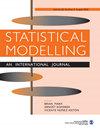一个由两部分组成的测量误差模型,用于估计参与未申报的工作和相关收入
IF 1.2
4区 数学
Q2 STATISTICS & PROBABILITY
引用次数: 0
摘要
在未申报的工作研究中,估计这种现象的规模(即收入数额和/或所涉工人的百分比)是一个重要的问题。这要么是通过间接方法,要么是通过特别调查的方式完成的,比如欧洲晴雨表对未申报工作的特别调查,这是我们的激励研究。未申报工作的程度可以通过两种不同的结果来衡量:表外工作事件(二元变量),以及当事件发生时,从未申报活动中获得的收益金额(连续变量)。这种设置通常是通过所谓的两部分模型来建模的:一个是观察到正与零结果的概率的二元选择模型,然后,以积极结果为条件,一个是积极结果的回归模型。我们提出了两个方向的两部分模型的扩展。第一个考虑到度量误差,考虑到未申报活动的本质,它最有可能影响两个结果。其次,我们推广了模型的线性回归部分,以允许个人水平的均值。我们还进行了广泛的仿真研究,以调查所提出的模型的性能,并将其与传统方法进行比较。本文章由计算机程序翻译,如有差异,请以英文原文为准。
A two-part measurement error model to estimate participation in undeclared work and related earnings
In undeclared work research, the estimation of the magnitude of the phenomenon (i.e., the amount of income and/or the percentage of workers involved) is of major interest. This has been done either using indirect methods or by means of ad hoc surveys such as the Eurobarometer special survey on undeclared work, our motivating study. The extent of undeclared work can be measured by means of two different outcomes: the event of working off-the-book (binary variable) and, when the event occurs, the amount of earnings deriving from the undeclared activity (continuous variable). This setup has been typically modeled via the so called two-part model: a binary choice model for the probability of observing a positive-versus-zero outcome and then, conditional on a positive outcome, a regression model for the positive outcome. We propose an extension of the two-part model that goes in two directions. The first regards the measurement error that, given the very nature of undeclared activities, is most likely to affect both the outcomes of interest. The second is that we generalize the linear regression part of the model to allow individual-level means. We also conduct an extensive simulation study to investigate the performance of the proposed model and compare it with traditional approaches.
求助全文
通过发布文献求助,成功后即可免费获取论文全文。
去求助
来源期刊

Statistical Modelling
数学-统计学与概率论
CiteScore
2.20
自引率
0.00%
发文量
16
审稿时长
>12 weeks
期刊介绍:
The primary aim of the journal is to publish original and high-quality articles that recognize statistical modelling as the general framework for the application of statistical ideas. Submissions must reflect important developments, extensions, and applications in statistical modelling. The journal also encourages submissions that describe scientifically interesting, complex or novel statistical modelling aspects from a wide diversity of disciplines, and submissions that embrace the diversity of applied statistical modelling.
 求助内容:
求助内容: 应助结果提醒方式:
应助结果提醒方式:


